Patented valve for lithium-ion battery housing
With the patented pressure equalization, pressure overload valve (DAÜ valve), tmax provides increased fire protection in battery housings.
The electrification of drives with lithium-ion batteries is progressing continuously, which is why safety aspects are also becoming increasingly important.
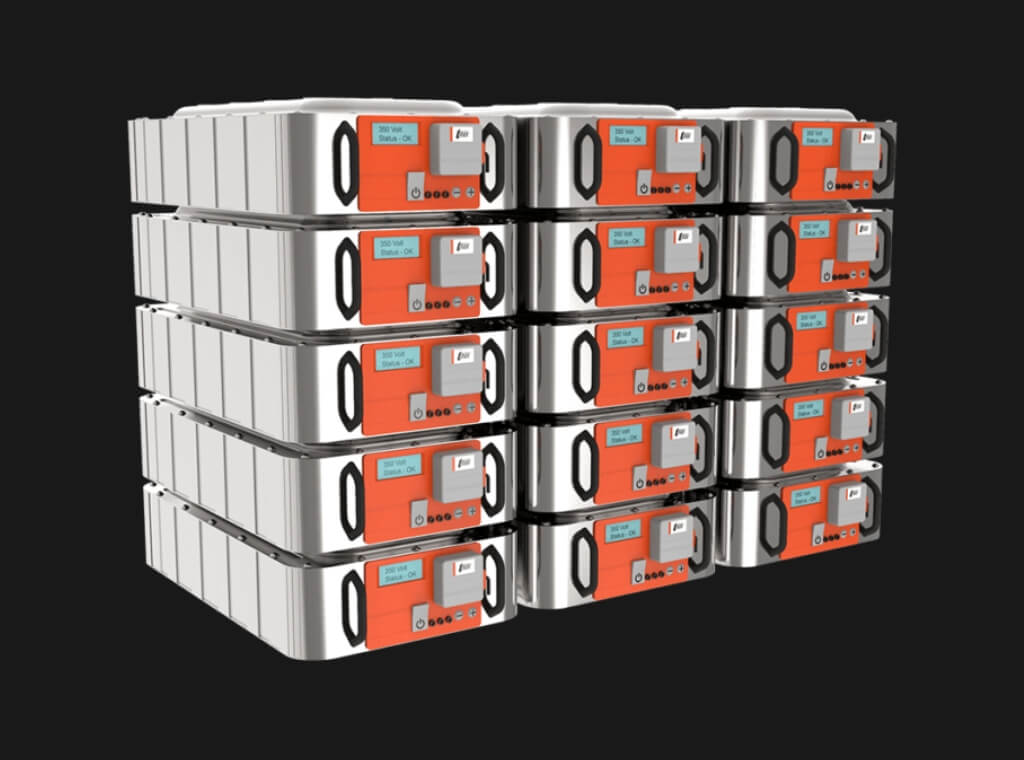
According to a study by Frost & Sullivan [1], 23,034 hybrid off-road vehicles were produced worldwide in 2017; 51,585 are projected for 2025. The study The Powertrain Transition by VDMA, FVA and FVV [2] also confirms this trend: It is expected that sales of hybrid drives in the output class from 56 to 150 kW in the studied segments of tractors, excavators, and wheel loaders will have a share ranging from 10 to 20% in Europe and the US in 2030.
Purely electric drives hardly play a role in Europe and the United States. In China, however, electric drives are projected to get a share of up to 8%. In the output class from 19 to 56 kW, the proportion of sales of electrical drives is expected to be up to 5% in 2030.
In the development of alternative drives for off-road applications, lithium-ion batteries take center stage. They offer relevant advantages such as high-energy density, a lower weight and volume, a very long shelf life due to low self-discharge, no memory effect (capacity loss caused by incomplete charging/discharging) and a high degree of efficiency. Because of their construction and particularly the use of certain chemical compounds in connection with high-energy densities, lithium-ion batteries carry the risks of specific dangers that pose new challenges to the fire safety of vehicles.
Lithium-ion batteries are energy storage systems which release chemically stored energy in the form of electrical energy during the discharging process. Starting at a certain operating temperature, the battery becomes subject to so-called thermal runaway, a process in which the entire energy of the cell is not released in a controlled way as electrical energy but rather uncontrolled in the form of thermal energy. In case of failure, a lithium-ion battery releases about seven to eleven times of the electrically stored energy in the form of thermal energy. This causes the battery to overheat. As a result of the high temperatures, some of the used cathode materials disintegrate [3]. Together with the thermal energy, the oxygen released in this process ignites the other battery components, creating temperatures of over 1000 °C. Lithium-ion batteries react sensitively to their environment and handling, which is why they are classified as dangerous goods for transport and storage. In no event should the energy sources be directly or permanently exposed to higher temperatures. tmax has developed a high-temperature resistant battery housing that protects the environment against the effects of thermal runaway, and the battery against the risks of excessive ambient temperatures - a high-temperature insulation. The following text addresses the development and individual safety components of the battery housing.
A battery housing consists of the actual stainless-steel housing, which creates the structural load capacity between the components, batteries, and control components in the interior. Lithium-ion batteries work optimally when they are operated in a temperature range between 18 and 25 °C. Maintaining this temperature range usually requires the use of a cooling system with a cooling plate. Additional functional and safety components in the housing are used for the various expansion levels. This includes materials which guarantee fire protection in case of a battery’s potential thermal runaway and which simultaneously protect the batteries in the interior against damaging external influences, such as high or low outside temperatures. In case a battery cell does catch fire, for example due to a short circuit, it is extremely important to safely release the reaction gases by means of a pressure relief valve. This ensures the protection of nearby persons and their safe evacuation from the danger zone. When batteries are used in vehicles, there is the potential danger of a collision with other road users or fixed objects. If the sensitive battery cells are damaged by a collision, this usually causes the entire vehicle to catch fire. To avoid the effects of such accidents, a crash structure is the optimal solution for bracing the impact of forces from the outside so that they won’t affect the sensitive battery cells.
The development of a new Battery Housing for Lithium-Ion Batteries starts with a detailed system analysis. Only an understanding of the total system makes it possible to implement the required development steps for the optimal battery protection correctly and in every detail. After the basic conditions of the battery pack are identified, they can be used to create a comprehensive system simulation of the intended application scenario. All input sizes are captured: battery dimensions (electrical enclosure), maximum and minimum ambient temperature, battery mass, specific heat capacity, degree of efficiency and the desired operating temperature of the battery. In the system simulation, the input values derived from the provided data would be calculated iteratively with data regarding the cooling design, the insulation and panel strength, the surrounding air gap, the maximum electrical output and required output of the used consumer over a defined period of, for example, three work days. Thus long-term effects can be integrated into the layout design. Data such as the battery temperature, electrical waste heat and heat flows, the required effective thermal cooling capacity and the resulting heat flow are calculated as a result.
FIGURE 1 shows the result of a simulation in which the entered basic conditions make it possible to derive an optimal housing design.
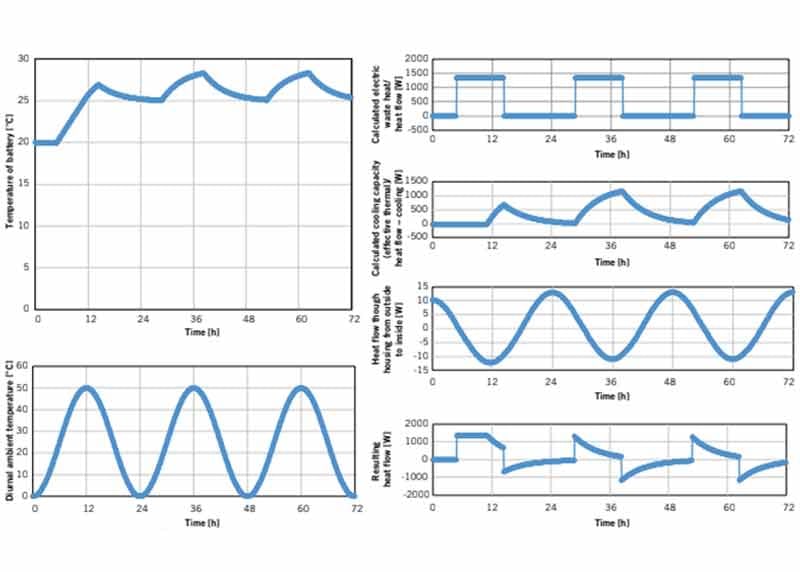
An essential point in the development of a Battery Housing for Lithium-Ion Batteries is general safety in case of fire. Two different scenarios are fundamentally possible. For one, a fire inside the housing, which is for example caused by a short circuit of the battery. For another, a fire outside the housing, which is created for example by a vehicle that has caught fire and which jeopardizes the sensitive battery cells. To examine the behavior of the battery-operated vehicles and vehicle parts, the ECE R100 standard is applied, and the battery housing is subjected to the required fire testing.
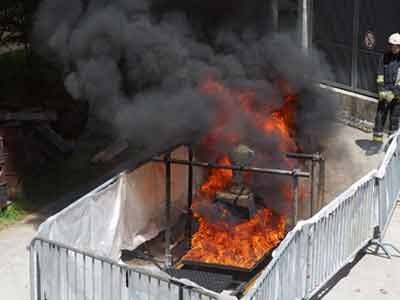
In this process, the housing is exposed to a direct gasoline flame that is placed beneath the housing after a 60-s heating phase. Then the housing is exposed to a flame directly for 70 s and indirectly for another 60 s.
FIGURE 2: The experiments utilized various insulation systems, all of which could satisfy the requirements for providing a thermal shield.
If there is a short circuit or damage to a battery cell that results in a fire of the reaction gases and, in an extreme case, to the propagation or ignition of other batteries connected to it, a considerable amount of flue gas is created.
If no constructive measures are taken, these highly toxic flue gases are released into the immediate environment unchecked and can damage the health of people in the vicinity. To ensure this does not happen, a patented pressure relief valve was developed that uses a semi-permeable membrane to prevent the entry of, for example, water, according to protection class IPx7, and balances out the natural heat expansion during the charging and discharging of the battery.
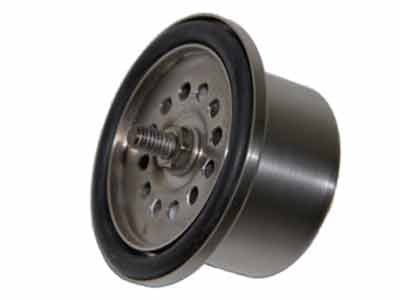
In this process, the housing is exposed to a direct gasoline flame that is placed beneath the housing after a 60-s heating phase. Then the housing is exposed to a flame directly for 70 s and indirectly for another 60 s.
FIGURE 3: In case of fire, the membrane melts and a spring mechanism in conjunction with an intumescent seal closes all the valve openings to the outside so that the battery housing is leakproof and no flue gas can escape. Since lithium-ion batteries are currently made mainly with oxidic cathode material due to the high charging density and good cycle stability, the ignited fire will supply itself with oxygen and continue to burn even in the sealed housing. When the pressure in the housing becomes too high and there is a threat of bursting, the valve opens and releases the pressurized gas from the housing in a con-trolled process.
Lithium-ion battery systems react sensitively to temperature gradients in their environment. If the temperatures exceed 60 °C, which can happen quickly due to direct sunlight and heat development in the battery cell during the charging and especially the discharging process, the disintegration of the electrolyte can lead to deposits on the anode, which can greatly increase the internal resistance of the cell. Effective and correctly measured cooling is very important in counteracting these destructive mechanisms.
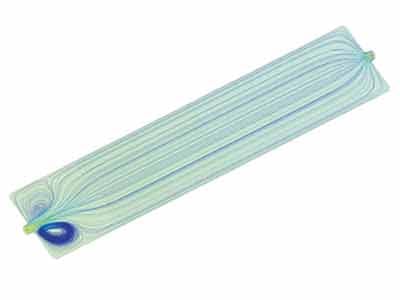 FIGURE 4: During the development of a battery housing concept, the design of the optimal cooling plate geometry is greatly accelerated with the aid of flow simulations, which make it possible to quickly compare different variants.
FIGURE 4: During the development of a battery housing concept, the design of the optimal cooling plate geometry is greatly accelerated with the aid of flow simulations, which make it possible to quickly compare different variants.
The aim of a crash concept in battery housings is to use an intermediate partition structure that converts as much kinetic impact energy into plastic deformation as possible in case of a crash. To this end, various concepts are developed and compared with each other through research activities and cooperation with universities of applied sciences, which include theoretical and simulative approaches as well as practical experiments. Finite element software and explicit calculation methods are used as research tools for the simulation of short-term dynamic processes. A test station was developed simultaneously to verify the theoretically gained results from the analysis and simulation. Meander-formed plate geometries with various radii, honey comb structures made of aluminum in a hexagonal and round design and aluminum foam sheets, among other things, are analyzed. Based on the selected load cases, for example a drop test from a height of 2 m, the mentioned concepts are dimensioned correspondingly and then solved explicitly. Then the concepts are compared by means of energy analytics and the values obtained from the simulation are validated in a practical test, applying a previously defined trial setup and the corresponding measurement technology.
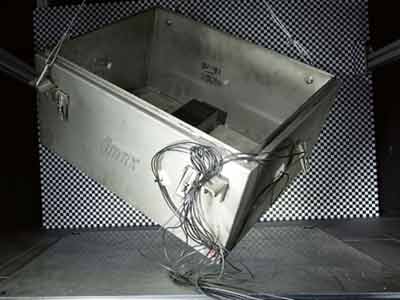 FIGURE 5: Stresses are determined directly in the highest load areas by applying strain gauges. By using a high speed camera, the spring-back rate of the housing and the vibration behavior can be captured and used to calculate the energy remaining in the system. Maximum accelerations that occur in the battery are detected with a 3-D acceleration sensor.
FIGURE 5: Stresses are determined directly in the highest load areas by applying strain gauges. By using a high speed camera, the spring-back rate of the housing and the vibration behavior can be captured and used to calculate the energy remaining in the system. Maximum accelerations that occur in the battery are detected with a 3-D acceleration sensor.
As the electrification of drives with lithium-ion batteries is on the rise and the power density of the batteries is continuously increasing, safety aspects are becoming ever more important. In line with this development, tmax has developed a Battery Housing for Lithium-Ion Batteries that uses various high temperature-resistant safety features to control the imminent dangers that go hand in hand with this progress.
REFERENCES
[1] Poggi, P.: Hybridization Trends in the Global Off-Highway Vehicle Market. Frost & Sullivan, iVT Expo, 2019
[2] N. N.: The Powertrain Transition. The electrification of powertrains in vehicles and its effect on machine and system construction and the subcontracting industry. VDMA, Frankfurt, 2018
[3] Buser, M.; Mähliß, J.: Lithiumbatterien. Brandgefahren und Sicherheitsrisiken. Online: https://www.riskexperts.at/fileadmin/downloads/ Lithiumbatterien/Lithiumbatterien__Sicherheitsratgeber__2016__BUSER-MAEHLISS.pdf, access: April 12, 2019
AUTHORS
Dipl.-Ing. (FH) Dominic Düser, M. Sc. is Development Engineer in the Area of Research and Design at Thermamax Hochtemperaturdämmungen GmbH in Mannheim (Germany).
Dipl.-Ing. (FH) Thomas Schramm is Director Engineering at Thermamax Hochtemperaturdämmungen GmbH in Mannheim (Germany).
Categories
Discover the world of insulation and how tmax, as a market leader, will also solve your requirements.
With the patented pressure equalization, pressure overload valve (DAÜ valve), tmax provides increased fire protection in battery housings.
Minimise fire risks. Optimise fire protection. The correct insulation solution is an important step towards safety. We explain why.
With proper exhaust tract insulation, all emission targets can be met and the efficiency of the exhaust gas aftertreatment system can be increased.